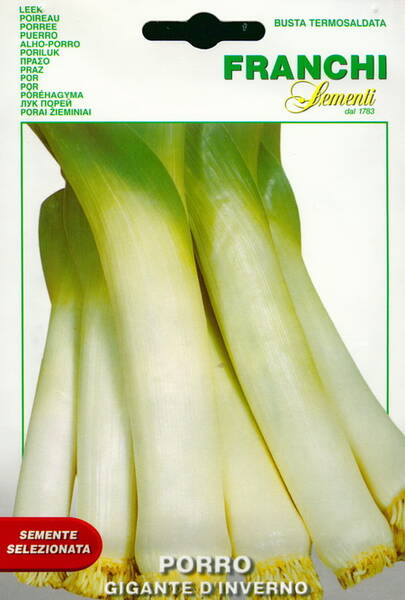Your shopping cart is empty!
European leek "Geant d hiver 2"
Garden Leek "Geant d`hiver 2".
Grown to obtain a bleached stem - "legs". The "stalk" shape is cylindrical, 3-4 cm in diameter (weight 200-300 g, height 15-20 cm).
The false stem and young, green leaves are used for food, colorless leaves during storage.
Leeks have a pleasant, slightly spicy taste. They are used fresh and stewed for preparing salads and other dishes.
Agrotechnics.
Under the leek, well-cultivated, fertile soils are taken away. The best predecessors for him are cabbage, cucumbers and legumes.
Leeks are grown through seedlings. Seeds are sown in late February - early March, and seedlings are planted in the ground in late April - early May, in furrows 6-10 cm deep,
the distance between rows is 25-30 cm, in a row 10-25 cm. Further care consists of systematic loosening of row-spacings, weeding, weeding plants, watering and fertilizing.
Leek has wonderful taste and a very valuable chemical composition.
It contains a lot of phosphorus and iron. The high content of potassium salts is especially valuable in the leek.
The plant contains essential oils, which include sulfur, which determines the specific aroma and peculiar taste of this onion.
Leek contains many vitamins. Vitamin C during storage not only does not decrease, but increases by almost 2 times due to the outflow from the leaves.
This onion has a lot of easily digestible sugar and little bitterness. Therefore, it is indispensable for dietary and baby food.
The healing properties of leek are also known: it is recommended to use it for patients with scurvy, rheumatism, obesity, physical and mental overwork,
as well as in urolithiasis.
Leeks can be eaten at any stage of growth. Young leaves are good in salads. Basically, bleached false stem - "leg" is used for food.
It is used to prepare various salads, sauces, and boiled to flavor soups, as a side dish for fish and meat dishes.
Grown to obtain a bleached stem - "legs". The "stalk" shape is cylindrical, 3-4 cm in diameter (weight 200-300 g, height 15-20 cm).
The false stem and young, green leaves are used for food, colorless leaves during storage.
Leeks have a pleasant, slightly spicy taste. They are used fresh and stewed for preparing salads and other dishes.
Agrotechnics.
Under the leek, well-cultivated, fertile soils are taken away. The best predecessors for him are cabbage, cucumbers and legumes.
Leeks are grown through seedlings. Seeds are sown in late February - early March, and seedlings are planted in the ground in late April - early May, in furrows 6-10 cm deep,
the distance between rows is 25-30 cm, in a row 10-25 cm. Further care consists of systematic loosening of row-spacings, weeding, weeding plants, watering and fertilizing.
Leek has wonderful taste and a very valuable chemical composition.
It contains a lot of phosphorus and iron. The high content of potassium salts is especially valuable in the leek.
The plant contains essential oils, which include sulfur, which determines the specific aroma and peculiar taste of this onion.
Leek contains many vitamins. Vitamin C during storage not only does not decrease, but increases by almost 2 times due to the outflow from the leaves.
This onion has a lot of easily digestible sugar and little bitterness. Therefore, it is indispensable for dietary and baby food.
The healing properties of leek are also known: it is recommended to use it for patients with scurvy, rheumatism, obesity, physical and mental overwork,
as well as in urolithiasis.
Leeks can be eaten at any stage of growth. Young leaves are good in salads. Basically, bleached false stem - "leg" is used for food.
It is used to prepare various salads, sauces, and boiled to flavor soups, as a side dish for fish and meat dishes.












